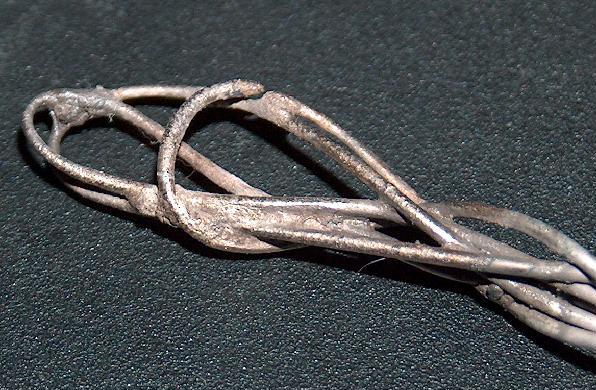Electrode Potentials in Fused Salt Systems
Tonight I ran a small experiment in which I produced P2O5 electrolytically from bone ash dissolved in an electrolyte of fused CaCl2 at around 900°C.
The experiment worked great in general; I used a very simple setup just as a proof of concept. I had a small steel cup of the electrolyte/feedstock
mixture in a miniature furnace, and suspended a water cooled copper coil over the top. Water from the furnace exhaust and surrounding air condensed
on the coil so I didn't get any dry P2O5, but a litmus test of the liquid left on the coil indicated very high acidity and thus successful production
of phosphoric acid. For the anode I used a graphite rod, and for the cathode I used a bundle of nichrome wire. Upon running, the smoke of P2O5 was
observed at the anode which condensed upon the water cooled coil, and burning calcium metal was observed whenever the cathode was pulled from the
melt. Little blobs of something could also be seen racing about on the surface of the melt, which quickly went away; it is unknown whether these were
blobs of burning calcium or subliming P2O5.
Anyway those are just the details of the experiment; the real part which forms the basis of this thread is what I observed on the cathode after
running the cell for probably no more than a minute in total. After washing away the residual salt, I saw that some parts of the cathode were eroded
thin and even completely broken in one spot, where other nearby areas showed complete welding together of wires. A picture of this cathode is shown
below and here. The only thing I can come up with is that a slight potential difference along the cathode caused nichrome to be dissolved at more positive
areas and deposited onto more negative areas. In a fully operational cell operating with fused CaCl2 electrolyte, then, surely the same thing would
occur if not significantly on the cathode, but also between the metallic cell wall and the cathode. I would gather than if the cell wall is more
positive than the cathode, it would be eroded away and plated onto the cathode, and if it is as or more negative then the product metal would be
deposited onto the wall if it is more electronegative than said product.
I am a bit puzzled as to how this can be prevented. If the potential between the cell wall and the cathode is forced by a separate protection circuit
to be less than the electrode potential between the wall metal and the product metal or cathode metal, I would think nothing would be transferred, and
if the wall is kept just more positive than the cathode I would not think product would tend to deposit on it. However even a slight difference
between areas of the same metal seems to cause a transfer. Since I would like to use this type of cell to produce a variety of metals and semi-metals
both more electropositive and more electronegative than a likely case material, say steel or inconel, this could pose a problem still. I guess I'm
not quite sure how this would all work or what else could be done to prevent cell wall erosion or deposits. If the cell wall were coated in a
material which is quite insoluble in the melt, there should not be a problem, however I am not sure that there exists a metal whose oxide is not
soluble here.
In FFC Cambridge cells I have read about the use of alumina, titanium, and inconel crucibles. My understanding is that alumina is normally quite
soluble in molten CaCl2; as far as I can tell the only way an alumina crucible could be prevented from dissolving is if the electrolyte was kept
saturated with calcium oxide or some product metal oxide. Titanium crucibles are undesireable entirely as these apparently oxidize very easily if the
electrolyte or the crucible is exposed to air at working temperature. I am also not clear on whether titanium would hold up electrolytically to all
the conditions I intend to subject my cells to. A graphite crucible is another possibility but I am not sure how it would behave electrolytically
either, plus graphite slowly combusts in air at the working temperature.
[Edited on 3-1-2009 by kilowatt]

The mind cannot decide the truth; it can only find the truth.
|